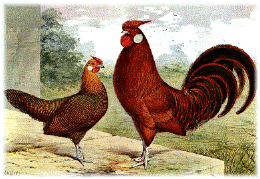It is almost
impossible to breed both sexes of Gold Pencilled Hamburghs of exhibition quality from the
one pen, two distinct strains are usually required.

Ludlow's painting from the later edition of Wright's Book of Poultry
Physical Attributes
Birds used for breeding
must be healthy, active and alert. They should have correct Hamburgh type and conform to
the correct weights. It is preferable to use birds slightly oversized, but with Pencilled
Hamburghs such birds are rare. NEVER breed with birds which
possess genetic physical deformities. These should be culled rigorously. The legs and feet
must be a lead grey colour, with no hint of green or yellow. The beak, horn coloured.
Head Points
All birds must have well
formed rose combs, (not coarse) free from hollows or dents. The comb must never be wider
than the skull. It must be square across the front and tapering to a round spike which
inclines slightly higher than the top surface of the comb. The lobes are always to be snow
white, as round as possible, thick and free from wrinkles or hollows and no larger than a
twenty cent piece (approx 30mm) in males and a ten cent piece (approx 20mm) in females.
Eyes are bright and alert and rich red in colour.
Important Things to Remember
Birds with genetic
physical deformities will ALWAYS pass these on to subsequent
generations. They may not appear in the first offspring but will reappear in the next
generation and usually in every odd generation henceforth, (ie. 3rd, 5th, 7th etc)
Males with head faults ALWAYS pass these faults onto subsequent
generations.
The head points are clearly seen from the outside of the showpen and few judges will place
a poor headed bird no matter how good it may be elsewhere.
Hamburghs have highest egg fertility when five females are run with each male. If you wish
to single mate, place four araucana hens in the pen with the Hamburgh female, the blue
eggs being easily identified.
Many strains of Gold Pencilled Hamburghs have Campine blood in them.
Dark eyes are a sure sign of tainted blood, and are almost impossible to eradicate.
Cull rigorously for faults. You cannot breed good birds from poor ones.
Keep your mind focussed on the kind of birds you want to produce and persist, persist,
persist.
Ensure you toe mark every chicken and keep accurate records so you know which pens your
best ones are coming from.
Always endeavour to improve the quality of your birds and if a particular mating yields
chickens of good quality, leave that pen mated together for as long as they breed true.
Poor hatchability is usually caused long before the egg is incubated. Give your breeding
birds vitamin supplements and a quality breeding ration for at least 3 months prior to
collecting their eggs. Never help a chick to hatch... if it is too weak to do it alone, it
will never be a good producing fowl later.
NEVER breed from weak or sickly chickens, these only produce
weak, sickly offspring. Get rid of any unthrifty birds.
This essay is written
from my own personal experiences and from hints given me by old breeders now passed on. |
Physical faults to avoid |
Wry
and squirrel tails
Knocked knees
Round backs
Protruding keels
Any other deformity |
Head faults to avoid |
Coarse
combs
Blade or flat leaders
Almond shaped lobes
Dished lobes
Lobes not perfectly white
Black or brown eyes
White in the face |
Campine blood is indicated by |
Dark
eyes
Too much black in the pencilling
Messy, poorly defined pencilling
Hen feathered males
Poor Hamburgh type
Appearance of single combed offspring
Ugly, coarse combs, sitting high off the head particularly in male chickens |
|